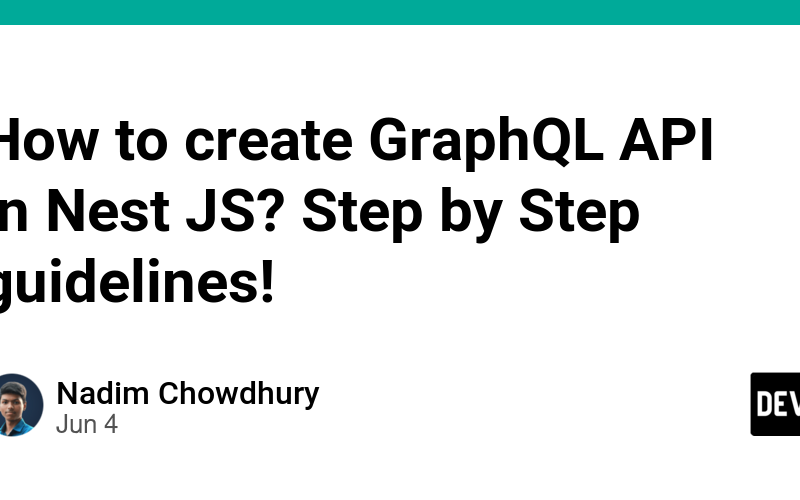Creating a GraphQL API in NestJS involves several steps. Here’s a step-by-step theoretical guide:
Step 1: Setup a New NestJS Project
- Install Nest CLI:
npm install -g @nestjs/cli
- Create a New Project:
nest new project-name
- Navigate to the Project Directory:
cd project-name
Step 2: Install GraphQL and Apollo Server
- Install Required Packages:
npm install @nestjs/graphql graphql apollo-server-express
Step 3: Configure GraphQL Module
-
Create a GraphQL Module Configuration:
Opensrc/app.module.tsand configure the GraphQL module:
import { Module } from '@nestjs/common';
import { GraphQLModule } from '@nestjs/graphql';
import { join } from 'path';
@Module({
imports: [
GraphQLModule.forRoot({
autoSchemaFile: join(process.cwd(), 'src/schema.gql'),
}),
],
})
export class AppModule {}
Step 4: Create a Resolver
-
Generate a Resolver:
Use the Nest CLI to generate a resolver:
nest g resolver user
-
Define Resolver Logic:
Opensrc/user/user.resolver.tsand define the resolver logic:
import { Resolver, Query, Mutation, Args } from '@nestjs/graphql';
import { UserService } from './user.service';
import { User } from './user.entity';
import { CreateUserInput } from './dto/create-user.input';
@Resolver(of => User)
export class UserResolver {
constructor(private readonly userService: UserService) {}
@Query(returns => [User])
async users() {
return this.userService.findAll();
}
@Mutation(returns => User)
async createUser(@Args('createUserInput') createUserInput: CreateUserInput) {
return this.userService.create(createUserInput);
}
}
Step 5: Create a Service
-
Generate a Service:
Use the Nest CLI to generate a service:
nest g service user
-
Implement Service Logic:
Opensrc/user/user.service.tsand implement the service logic:
import { Injectable } from '@nestjs/common';
import { User } from './user.entity';
import { CreateUserInput } from './dto/create-user.input';
@Injectable()
export class UserService {
private users: User[] = [];
findAll(): User[] {
return this.users;
}
create(createUserInput: CreateUserInput): User {
const user = { ...createUserInput, id: Date.now().toString() };
this.users.push(user);
return user;
}
}
Step 6: Define GraphQL Schema and DTOs
-
Create GraphQL Schema and DTOs:
Create thesrc/user/user.entity.ts:
import { ObjectType, Field, ID } from '@nestjs/graphql';
@ObjectType()
export class User {
@Field(type => ID)
id: string;
@Field()
name: string;
@Field()
email: string;
}
Create the src/user/dto/create-user.input.ts:
import { InputType, Field } from '@nestjs/graphql';
@InputType()
export class CreateUserInput {
@Field()
name: string;
@Field()
email: string;
}
Step 7: Update Module
-
Update the Module to include Resolver and Service:
Opensrc/user/user.module.tsand update it:
import { Module } from '@nestjs/common';
import { UserService } from './user.service';
import { UserResolver } from './user.resolver';
@Module({
providers: [UserService, UserResolver],
})
export class UserModule {}
Step 8: Integrate the User Module
-
Integrate the User Module into the App Module:
Opensrc/app.module.tsand update it:
import { Module } from '@nestjs/common';
import { GraphQLModule } from '@nestjs/graphql';
import { join } from 'path';
import { UserModule } from './user/user.module';
@Module({
imports: [
GraphQLModule.forRoot({
autoSchemaFile: join(process.cwd(), 'src/schema.gql'),
}),
UserModule,
],
})
export class AppModule {}
Step 9: Run the Application
- Start the NestJS Application:
npm run start:dev
Step 10: Test the GraphQL API
-
Access the GraphQL Playground:
Navigate tohttp://localhost:3000/graphqlto access the GraphQL playground and test your API by running queries and mutations.
This guide provides a foundational approach to creating a GraphQL API in NestJS. You can further expand and customize it based on your application’s requirements.
Disclaimer: This content in generated by AI.
Source link
lol

